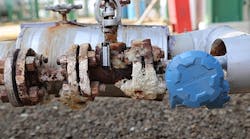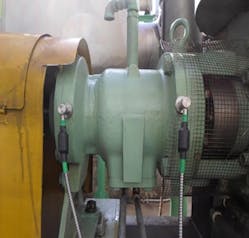Denka Chemical’s Seraya plant in Singapore took a unique approach to overcoming a variety of process challenges. Using close partnerships with vendors to spearhead its digital transformation journey, Denka’s team was able to achieve its full vision — using new diagnostic applications for preemptive equipment analysis while automating outdated practices and improving the overall operability of the plant.
The digitalization initiative spanned a number of years. It started by addressing three particular operational issues and then, bolstered by success there, expanded to other important areas.
A key consideration when deploying the digital operational infrastructure was not to disturb the plant’s distributed control system (DCS). So, the new infrastructure adheres to NAMUR open architecture — that is, Emerson’s Plantweb system used for digital transformation is a second layer of automation on the side of the DCS. This preserves the safety and robustness of the DCS. At the same time, it enables freely adding new analytics apps to the application framework and deploying more sensors on the same wireless sensor network. Most of the sensors used are non-intrusive and, therefore, easy to install even while the plant is operating.
Initial Targets
The effort first focused on the plant’s steam traps, to detect and reduce steam loss and, thus, lower production cost. Next came implementation of a pump health monitoring system. Denka used an off-the-shelf analytics framework with ready-made apps for steam traps, relief valves, pressure gauges, wireless networks and battery management. The result was a reduction in steam loss and pressure release incidents that lowered costs and increased sustainability. Lastly, to improve alerts and emergency awareness, the plant established a software portal to send push notifications to employee smartphones in real-time, decreasing emergency response times.
Reducing steam loss. Previously, the plant had used an external contractor to conduct annual steam trap surveys. This manual process made it easy to miss equipment failure; it was clear that failed steam traps were causing steam loss.
So, Denka collaborated with Emerson to solve the steam loss problem using the Industrial Internet of Things (IIoT) with WirelessHART acoustic sensors (Figure 1) — a first-ever application for Denka and Emerson of a 4G router sending data analytics to the cloud. Proof-of-concept began in August 2015, full operation started in March 2016, and scale-out took place in September 2018. The number of traps with acoustic sensors has increased gradually over the years; now the monitoring covers most traps.
Figure 1. Acoustic and temperature sensors mounted on trap send data via WirelessHART.
As a connected service, the maintenance department receives a report from Emerson that lists which steam traps to replace. The reporting format was co-created in a design-thinking process in several iterations, perfecting the content and layout to make the job on-site easy.
As a result, identification and replacement of failed steam traps — and stoppage of steam loss — now occurs much sooner, lowering steam consumption by 7% and, thus, reducing energy cost and improving sustainability. The systems also ensure product heating, increasing product quality and yield. The approach avoids time-consuming cleanouts and delays associated with off-specification batches.
Improving cooling tower and conventional pump reliability and maintenance. In the past, preventive maintenance (PM) relied on a manual survey of rotating equipment using a portable vibration tester. Inspection took place monthly or weekly depending on the asset. Inconsistent monitoring meant the plant suffered from surprise failures, which led to difficult and expensive repair. Cooling tower gearboxes are particularly challenging to monitor because they are located inside the protective shroud around the fan. Failure cuts cooling capacity and reduces production capacity. Similarly, pump bearing failure causes serious damage to the impeller and housing due to extreme operating temperature. Temperatures of around 300°C at high-speed operation can lead to expensive repair and downtime. A need clearly existed to predict cooling tower gearbox and pump failures to help target these issues.
In this case, no proof of concept was necessary. Permanent installation of wireless vibration transmitters to monitor pumps and cooling tower gearboxes began in September 2018. Each accelerometer on a cooling tower gearbox has a short cable connecting it to a wireless transmitter on the outside of the shroud (Figure 2). Data go to an IIoT-based connected service provided by Emerson but the on-premises Plantweb system also shows real-time information. The periodic report from Emerson predicts bearing issues. Findings for cooling towers include poor lubrication or weakened structure (descriptive analytics) and data to drive maintenance activity such as oil changes (prescriptive analytics).
Figure 2. Vibration sensors on cooling tower gearbox send data via a short cable to wireless transmitter on the outside of the shroud.
Personnel now get a software alert in case abnormality is predicted. The monitoring has resulted in reduced downtime and maintenance cost for the cooling towers and pumps. Production can now sustain full capacity without stoppages. Pump impellers and housings have suffered reduced serious damage; this should extend the time between overhauls to five years from three years.
Further Steps
These positive results spurred broader efforts related to canned motor pump diagnostics, flaring/abnormal-release monitoring, fire protection systems, network management and a connected workforce. Proof of concept began in March 2020 (and took somewhat longer because of COVID-19); full operation started in September 2020.
Canned motor pump diagnostics. Unlike in regular centrifugal pumps, the bearings of canned motor pumps are not exposed, which inhibits the standardized fitting of a vibration sensor. Fortunately, the pump manufacturer had accounted for this issue by providing probes in the stator coil to detect wear of bearings and can display these health metrics by monitor. Unfortunately, indication is local or via wired remote. The plant has many of these hermetically sealed pumps and, thus, needed wireless remote indication.
Denka and Emerson engineers collaborated and eventually settled on a wireless design. During the design process, they ensured hazardous area requirements were met. Similarly, the graphical-user-interface design was co-created and perfected through rapid prototyping that experimented with a few different formats during the proof of concept to get the desired usability. The pump supplier also took part in the testing. Yet, no custom code programming was required, only custom configuration of off-the-shelf user interface software. As a result, the plant now benefits from prediction of problems in canned pumps that enables less downtime and longer operation, thus reducing maintenance cost.
Flaring/abnormal release monitoring. Another objective was to decrease product losses and help with sustainable practices by reducing flaring or abnormal releases from pressure relief valves (PRVs). Frequent manual inspection of them is not practical. Instead, it is common for a site to perform PRV leak test and repair in batches during a shutdown. This ultimately ends up becoming costly because most PRVs don’t require repair.
Here, too, Denka opted for WirelessHART acoustic sensors. The WirelessHART gateway connects to the PRV analytics over Ethernet using the HART-IP protocol. Off-the-shelf software designed specifically for PRV monitoring was installed as part of the same application framework. Because the app is ready-made, no algorithm training was required. The system worked out of the box. The software is successfully deployed in many other plants across all kinds of industries around the world, so no lengthy proof of concept was necessary.
In addition, the plant fitted rupture discs with wireless pressure gauges to detect releases and premature leakage.
Earlier detection and repair has reduced flaring or abnormal releases and, thus, made operations more sustainable.
Fire protection system. Besides direct operational benefits, digitalization also can enhance safety such as by keeping tabs on fire protection systems. In September 2020, the plant began monitoring to alert operations to leaks in the firefighting water line and activation of the fire protection system. This involved installation of wireless pressure gauges for these measurements that share the same WirelessHART network as the other wireless sensors. Mixing multiple wireless technologies was not necessary.
Network management. The digital transformation of tasks in the plant had led to deployment of many wireless sensors. Instrument engineers wanted to ensure they did not face issues with the wireless network or batteries in the future.
Another app in the application framework monitors the health of the wireless sensor network and the status of the battery in each wireless device. It notifies technicians if it detects any weakness in the network due to activities in the plant and provides an early warning if a battery is low.
As a result, the wireless network is kept in good condition supporting the activities in the plant.
Connected workforce. People need access to information wherever they are. So, the plant deployed the Plantweb system’s messaging portal app to provide an alert in case of a failure, leak or other issue. The software not only shows this but also sends out a notification to the mobile phone of the person responsible for handling the matter. These mobile on-the-go notifications foster quicker responses to problems. Again, consistent with the philosophy of using ready-made software, no custom code programming was required.
Holistic Success
The use cases already have proven themselves. Every operational department in the plant has benefited from reduced energy and maintenance costs, better loss control, and improved availability, product quality and safety. Digitalization has enhanced overall productivity and helps ensure business continuity during events that require limiting the number of personnel, both staff and external contractors, such as when following COVID-19 social distancing protocols. Digital transformation continues to expand into new use cases.
NG HOCK CHEONG is maintenance manager for Denka Singapore Pte. Ltd., Singapore, a unit of Denka Chemicals. Email him at [email protected].


